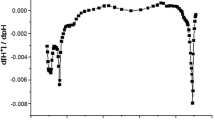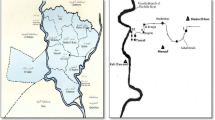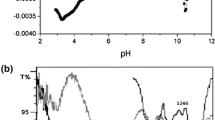Abstract
The study reports biosorptive removal of uranium(VI) water contamination by a wild epiphytic orchid plant: Vanda tessellata. This orchid plant was chosen based on abundant availability and adsorption efficacy. In batch mode operation the maximum uranium(VI) adsorption capacity was found as 416 μg g−1 of dry biomass. The optimum pH for adsorption was neutral (7), and the equilibrium time was 15 min at 30 ± 5 °C temperature. The adsorbent properties were characterized by SEM, EDS, and FTIR techniques. The effects of various variables like pH, initial ion concentration, biosorbent dose, contact time, and temperature on the adsorption process were studied. The Langmuir isotherm showed better agreement (R2 = 0.987) to describe the adsorption process, and the adsorption process followed pseudo-second-order kinetics. The thermodynamic study showed the endothermic, and spontaneous nature of adsorption in a feasible manner. The adsorbent can be used for developing a remedial method for uranium contamination in the water.












Similar content being viewed by others
References
Keith S, Faroon O, Roney N, Scinicariello F, Wiber S, Lngerman L, Llados F, Plewak D, Wohlers D, Diamond G (2013) Toxicological profile for uranium. Agency for Toxic Substances and Disease Registry (US), Atlanta (GA)
Kale A, Bandela N, Kulkarni J (2020) Assessment of chemo-radiological risk of naturally occurred uranium in groundwater from the Beed district, India. J Radioanal Nucl Chem 323:151–157. https://doi.org/10.1007/s10967-019-06849-3
World Health Organization (2011) Guidelines for drinking water. World Health Organization, Geneva
AERB (Atomic Energy Regulatory Board) (2004) Directive for limit on uranium in drinking water, Mumbai, India
Yadav AK, Sahoo SK, Mahapatra S, Kumar AV, Pandey G, Lenka P, Tripathi RM (2014) Concentrations of uranium in drinking water and cumulative, age-dependent radiation doses in four districts of Uttar Pradesh, India. Toxicol Environ Chem 96:192–200. https://doi.org/10.1080/02772248.2014.934247
Tan Y, Le L, Zhang H, Ding D, Dai Z, Xue J, Liu J, Hu N, Wang Y (2018) Adsorption and recovery of U(VI) from actual acid radioactive wastewater with low uranium concentration using thioacetamide modified activated carbon from liquorice residue. J Radioanal Nucl Chem 317:811–824. https://doi.org/10.1007/s10967-018-5952-8
Ahmed SH, Sharaby CM, El Gammal EM (2013) Uranium extraction from sulfuric acid medium using trioctylamine impregnated activated carbon. Hydrometallurgy 134–135:150–157. https://doi.org/10.1016/j.hydromet.2013.02.003
Afsari M, Safdari J, Towfighi J, Mallah MH (2012) The adsorption characteristics of uranium hexafluoride onto activated carbon in vacuum conditions. Ann Nucl Energy 46:144–151. https://doi.org/10.1016/j.anucene.2012.03.031
Bayramoglu G, Arica MY (2016) MCM-41 silica particles grafted with polyacrylonitrile: modification in to amidoxime and carboxyl groups for enhanced uranium removal from aqueous medium. Microporous Mesoporous Mater 226:117–124. https://doi.org/10.1016/j.micromeso.2015.12.040
Abubakar M, Tamin MN, Saleh MA, Uday MB, Ahmad N (2016) Preparation and characterization of a nigerian mesoporous clay-based membrane for uranium removal from underground water. Ceram Int 42:8212–8220. https://doi.org/10.1016/j.ceramint.2016.02.031
Nekhunguni PM, Tavengwa NT, Tutu H (2017) Sorption of uranium(VI) onto hydrous ferric oxide-modified zeolite: Assessment of the effect of pH, contact time, temperature, selected cations and anions on sorbent interactions. J Environ Manag 204:571–582. https://doi.org/10.1016/j.jenvman.2017.09.034
Shao L, Wang X, Ren Y, Wang S, Zhong J, Chu M, Tang H, Lue L, Xie D (2016) Facile fabrication of magnetic cucurbit[6]uril/graphene oxide composite and application for uranium removal. Chem Eng J 286:311–319. https://doi.org/10.1016/j.cej.2015.10.062
Mahfouz MG, Galhoum AA, Gomaa NA, Abdel-rahem SS, Atiya AA, Vincent T, Guibal E (2015) Uranium extraction using magnetic nano-based particles of diethylenetriamine-functionalized chitosan: equilibrium and kinetic studies. Chem Eng J 262:198–209. https://doi.org/10.1016/j.cej.2014.09.061
Wei J, Zhang X, Liu Q, Li Z, Liu L, Wang J (2014) Magnetic separation of uranium by CoFe2O4 hollow spheres. Chem Eng J 241:228–234. https://doi.org/10.1016/j.cej.2013.12.035
Kryvoruchko AP, Yurlova LY, Atamanenko ID, Korinilovich BY (2004) Ultrafiltration removal of U(VI) from contaminated water. Desalination 162:229–236. https://doi.org/10.1016/S0011-9164(04)00046-3
Zhang L, Zhang X, Lu Q, Wu X, Jiang T, Mi L, Peng Y (2019) Adsorption of U(VI) ions from aqueous solution using nanogoethite powder. Adsorpt Sci Technol 37:113–126. https://doi.org/10.1177/0263617418816202
Nilchi A, Shariati Dehaghan T, Rasouli Garmarodi S (2013) Kinetics, isotherm and thermodynamics for uranium and thorium ions adsorption from aqueous solutions by crystalline tin oxide nanoparticles. Desalination 321:67–71. https://doi.org/10.1016/j.desal.2012.06.022
Sadeghi S, Azhdari H, Arabi H, Moghaddam AZ (2012) Surface modified magnetic Fe3O4 nanoparticles as a selective sorbent for solid phase extraction of uranyl ions from water samples. J Hazard Mater 215–216:208–216. https://doi.org/10.1016/j.jhazmat.2012.02.054
Kong L, Zhu Y, Wang M, Li Z, Tan Z, Xu R, Tang H, Chang X, Xiong Y, Chen D (2016) Simultaneous reduction and adsorption for immobilization of uranium from aqueous solution by nano-flake Fe-SC. J Hazard Mater 320:435–441. https://doi.org/10.1016/j.jhazmat.2016.08.060
Wang Y, Gu Z, Yang J, Liao J, Yang Y, Liu N, Tang J (2014) Amidoxime-grafted multiwalled carbon nanotubes by plasma techniques for efficient removal of uranium(VI). Appl Surf Sci 320:10–20. https://doi.org/10.1016/j.apsusc.2014.08.182
Kar AS, Kumar S, Tomar BS (2012) U(VI) sorption by silica: effect of complexing anions. Colloids Surf Physicochem Eng Asp 395:240–247. https://doi.org/10.1016/j.colsurfa.2011.12.038
Gao J-K, Hou L-A, Zhang G-H, Gu P (2015) Facile functionalized of SBA-15 via a biomimetic coating and its application in efficient removal of uranium ions from aqueous solution. J Hazard Mater 286:325–333. https://doi.org/10.1016/j.jhazmat.2014.12.061
Vivero-Escoto JL, Carboni M, Abney CW, DeKrafft KE, Lin W (2013) Organo-functionalized mesoporous silicas for efficient uranium extraction. Microporous Mesoporous Mater 180:22–31. https://doi.org/10.1016/j.micromeso.2013.05.030
Ivanova B, Spiteller M (2014) Adsorption of uranium composites onto saltrock oxides—experimental and theoretical study. J Environ Radioact 135:75–83. https://doi.org/10.1016/j.jenvrad.2014.03.019
Khani MH, Keshtkar AR, Ghannadi M, Pahlavanzadeh H (2008) Equilibrium, kinetic and thermodynamic study of the biosorption of uranium onto Cystoseria indica algae. J Hazard Mater 150:612–618. https://doi.org/10.1016/j.jhazmat.2007.05.010
Bajwa BS, Kumar S, Singh S, Sahoo SK, Tripathi RM (2017) Uranium and other heavy toxic elements distribution in the drinking water samples of SW-Punjab, India. J Radiat Res Appl Sci 10:13–19. https://doi.org/10.1016/j.jrras.2015.01.002
Saini K, Bajwa BS (2016) Uranium distribution study in the drinking water samples of SW Punjab, India. Adv Appl Sci Res 7(2):103–108
Narang S, Kumar D, Kumar A (2018) Health-related analysis of uranium in Fazilka district, Punjab, India. Curr Sci 115:2079
Nagaiah N, Mathews G, Balakrishna KK, Ranjana AM, Naregundi K (2013) Influence of physico-chemical parameters on the distribution of uranium in the ground water of Bangalore, India. Radiat Prot Environ 36:175–180
Rani A, Mehra R, Duggal V, Balaram V (2013) Analysis of uranium concentration in drinking water samples using ICPMS. Health Phys 104:251–255. https://doi.org/10.1097/HP.0b013e318279ba05
Gascoyne M (1989) High levels of uranium and radium in groundwaters at Canada’s Underground Research Laboratory, Lac du Bonnet, Manitoba, Canada. Appl Geochem 4:577–591. https://doi.org/10.1016/0883-2927(89)90068-1
Amakom C, Jibiri N (2010) Chemical and radiological risk assessment of uranium in borehole and well waters in the Odeda Area, Ogun State, Nigeria. Int J Phys Sci 5:1009–1014
Stalder E, Blanc A, Haldimann M, Dudler V (2012) Occurrence of uranium in Swiss drinking water. Chemosphere 86:672–679. https://doi.org/10.1016/j.chemosphere.2011.11.022
Vesterbacka P, Mäkeläinen I, Arvela H (2005) Natural radioactivity in drinking water in private wells in Finland. Radiat Prot Dosim 113:223–232. https://doi.org/10.1093/rpd/nch446
Prakash B, Bais RT (2016) A Novel chemical compound from the leaf extract of Vanda tessellata (Roxb.) Hook. ex G. Don. World J Pharm Res 5:10
Ricks AM, Gagliardi L, Duncan MA (2010) Infrared spectroscopy of extreme coordination: the carbonyls of U+ and UO2+. J Am Chem Soc 132:15905–15907. https://doi.org/10.1021/ja1077365
Sahu C, Khan F, Pandey PK, Pandey M (2017) Biosorptive removal of toxic contaminant lead from wastewater. Asian J Chem 29:650–656
Sahu C, Khan F, Pandey PK, Pandey M (2017) Proficient removal of As (III) from water using orchid plant (Vanda sp.) as biosorbent. Asian J Chem 29:1790–1796
Gardiner LM, Kocyan A, Motes M, Robert DL, Emerson BC (2013) Molecular phylogenetics of Vanda and related genera (Orchidaceae): Molecular Phylogenetics of Vanda. Bot J Linn Soc 173:549–572. https://doi.org/10.1111/boj.12102
Sahu SK, Maity S, Bhangare RC, Pandit GG, Sharma DN (2014) Determination of uranium in ground water using different analytical technique, vol 34. Bhabha Atomic Research Centre, Mumbai
Tian G, Geng J, Jin Y, Wang C, Li S, Chen Z, Wang H, Zhao Y, Li S (2011) Sorption of uranium(VI) using oxime-grafted ordered mesoporous carbon CMK-5. J Hazard Mater 190:442–450. https://doi.org/10.1016/j.jhazmat.2011.03.066
Coates J (2006) Interpretation of infrared spectra, a practical approach. Encycl Anal Chem Appl Theory Instrum 1–23
Wang J, Zhuang S (2019) Extraction and adsorption of U(VI) from aqueous solution using affinity ligand-based technologies: an overview. Rev Environ Sci Biotechnol 18(3):437–452
Wang X, Xia L, Tan K, Zheng W (2012) Studies on adsorption of uranium (VI) from aqueous solution by wheat straw. Environ Prog Sustain Energy 31:566–576
Yusan SD, Erenturk SA (2011) Sorption behaviors of uranium (VI) ions on α-FeOOH. Desalination 269:58–66
Xiao-teng Z, Dong-mei J, Yi-qun X, Jun-chang C, Shuai H, Liang-shu X (2019) Adsorption of uranium(VI) from aqueous solution by modified rice stem. J Chem 2019:1–10. https://doi.org/10.1155/2019/6409504
Yu J, Wang J, Jiang Y (2017) Removal of uranium from aqueous solution by alginate beads. Nucl Eng Technol 49:534–540. https://doi.org/10.1016/j.net.2016.09.004
Rong L, Zeming S, Yun H, Kailiang Z, Junji Z, Xinyu W, Ke C, Lvhang Y (2019) Uranium sorption onto mullite: characteristics of isotherms, kinetics and thermodynamics. J Earth Syst Sci 128:176
Saha R, Das S, Banerjee A, Sahana A, Sudarsan M, Slawin AMZ, Li Y, Das D (2010) pH dependent separation of uranium by chelation chromatography using pyridine 2,6-dimethanol as a chelator: single crystal X-ray structural confirmation of the chelated uranium complex. J Hazard Mater 181:154–160. https://doi.org/10.1016/j.jhazmat.2010.04.111
Zhao Y, Liu C, Feng M, Chen Z, Li S, Tian G, Wang L, Huang J, Li S (2010) Solid phase extraction of uranium(VI) onto benzoylthiourea-anchored activated carbon. J Hazard Mater 176:119–124. https://doi.org/10.1016/j.jhazmat.2009.11.005
Hazer O, Kartal Ş (2010) Use of amidoximated hydrogel for removal and recovery of U(VI) ion from water samples. Talanta 82:1974–1979. https://doi.org/10.1016/j.talanta.2010.08.023
Aytas S, Turkozu DA, Gok C (2011) Biosorption of uranium(VI) by bi-functionalized low cost biocomposite adsorbent. Desalination 280:354–362. https://doi.org/10.1016/j.desal.2011.07.023
Sert Ş, Eral M (2010) Uranium adsorption studies on aminopropyl modified mesoporous sorbent (NH2–MCM-41) using statistical design method. J Nucl Mater 406:285–292. https://doi.org/10.1016/j.jnucmat.2010.08.024
Song Q, Ma L, Liu J, Bai C, Geng J, Wang H, Li B, Wang L, Li S (2012) Preparation and adsorption performance of 5-azacytosine-functionalized hydrothermal carbon for selective solid-phase extraction of uranium. J Colloid Interface Sci 386:291–299. https://doi.org/10.1016/j.jcis.2012.07.070
Yusan S, Akyil S (2008) Sorption of uranium(VI) from aqueous solutions by akaganeite. J Hazard Mater 160:388–395. https://doi.org/10.1016/j.jhazmat.2008.03.009
Kushwaha S, Sudhakar PP (2013) Sorption of uranium from aqueous solutions using palm-shell-based adsorbents: a kinetic and equilibrium study. J Environ Radioact 126:115–124
Wang G, Wang X, Chai X, Liu J, Deng N (2010) Adsorption of uranium (VI) from aqueous solution on calcined and acid-activated kaolin. Appl Clay Sci 47:448–451. https://doi.org/10.1016/j.clay.2009.11.003
APHA (1999) Standard methods for the examination of water and wastewater. In: Water environment federation american water works association, 23rd edition. American Public Health Association, Washington, DC
Author information
Authors and Affiliations
Corresponding author
Ethics declarations
Conflict of interest
The authors declare that they have no known competing financial interests or personal relationships that could have appeared to influence the work reported in this paper.
Additional information
Publisher's Note
Springer Nature remains neutral with regard to jurisdictional claims in published maps and institutional affiliations.
Rights and permissions
About this article
Cite this article
Pandey, P., Pandey, M. & Pandey, P.K. Uranium contamination removal from water by an orchid (Vanda tessellata) based biosorbent. J Radioanal Nucl Chem 328, 89–101 (2021). https://doi.org/10.1007/s10967-021-07638-7
Received:
Accepted:
Published:
Issue Date:
DOI: https://doi.org/10.1007/s10967-021-07638-7




